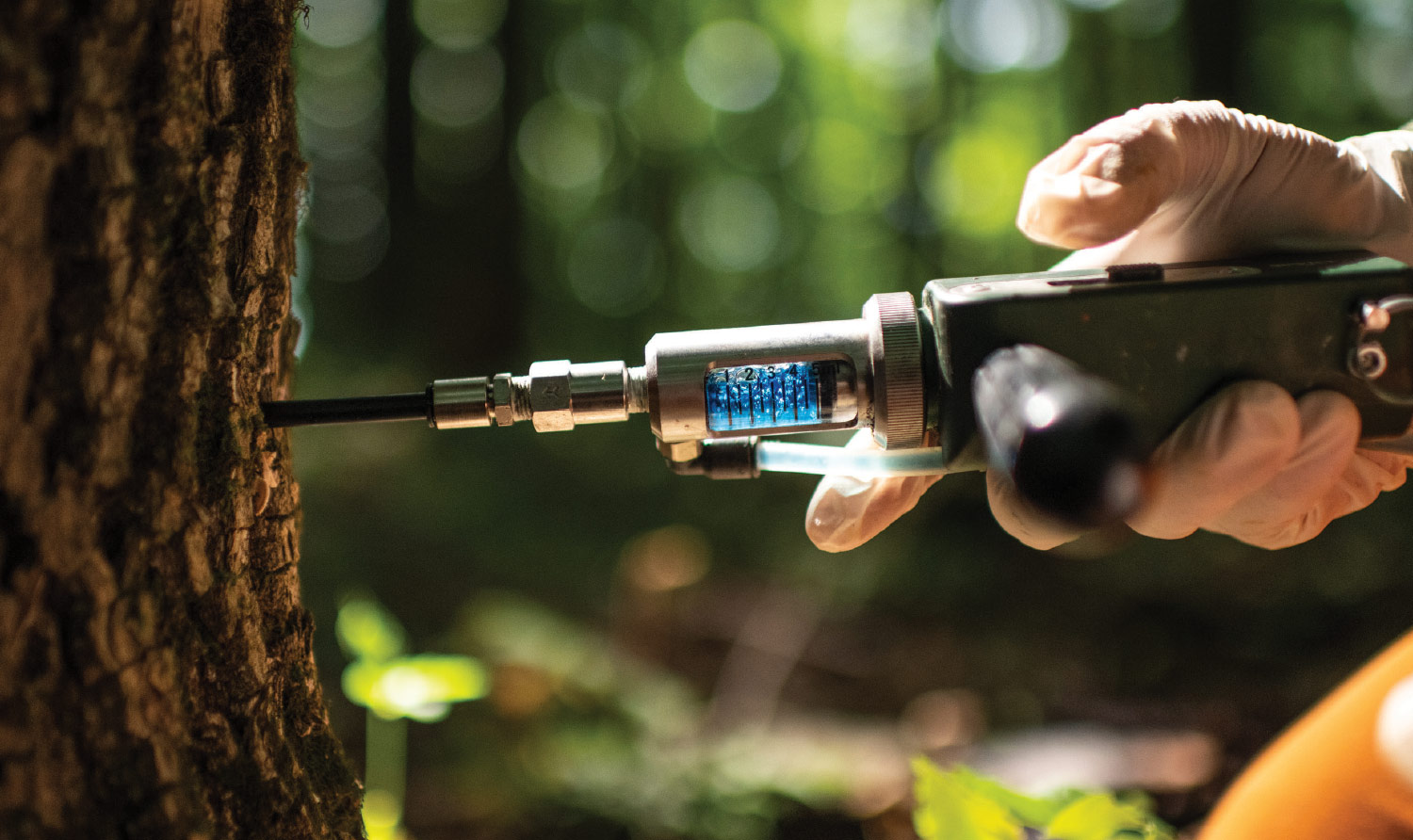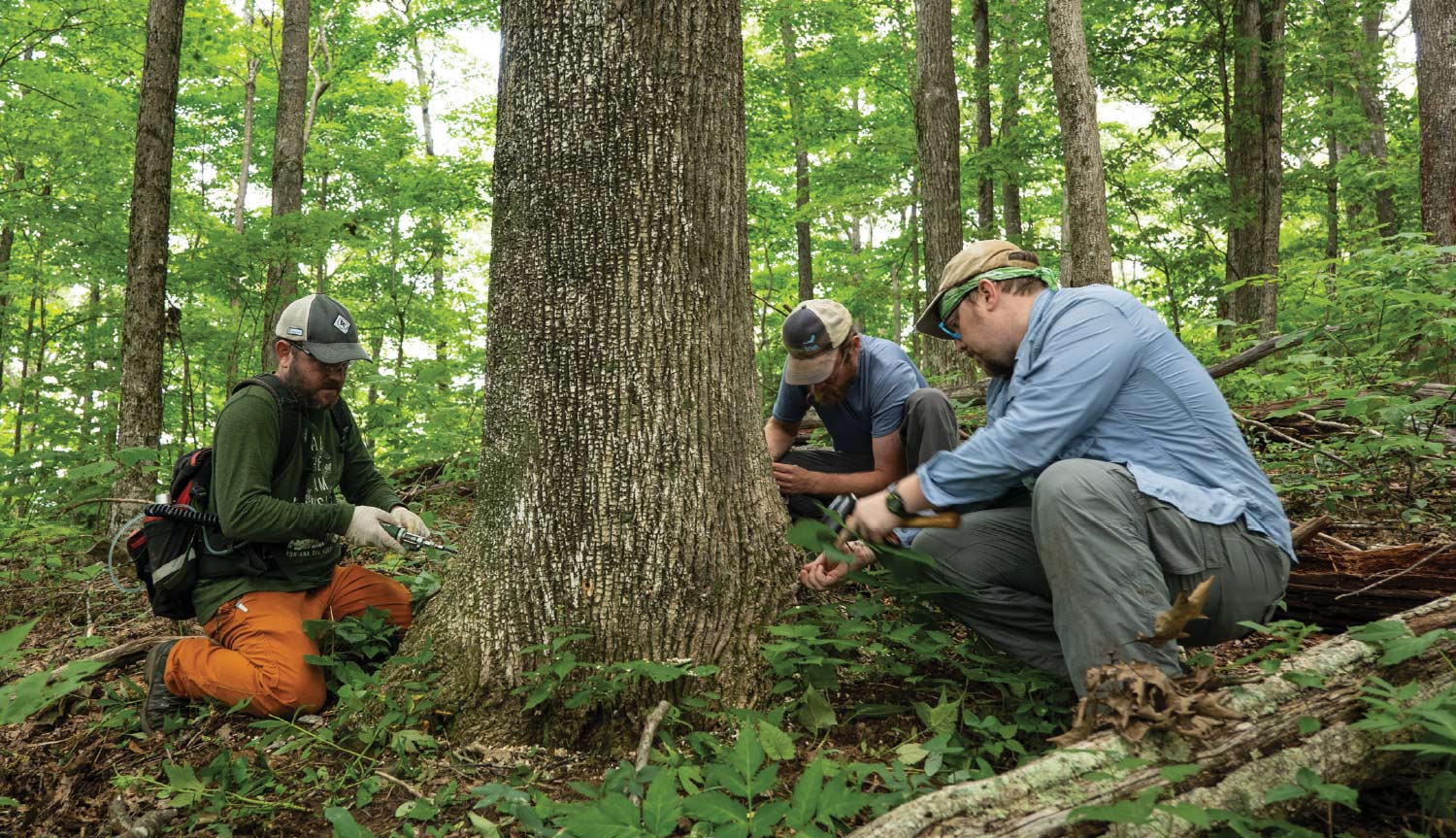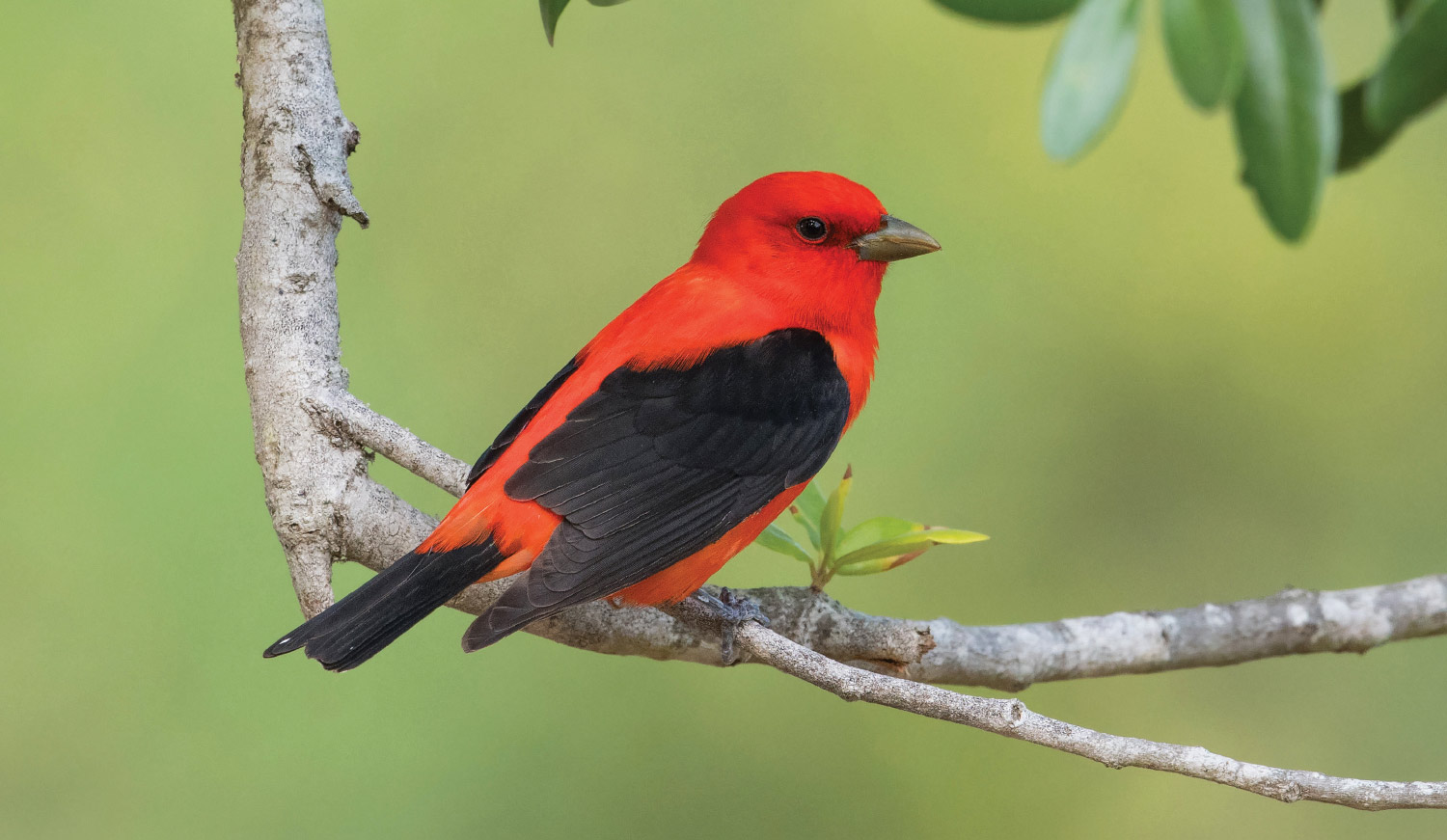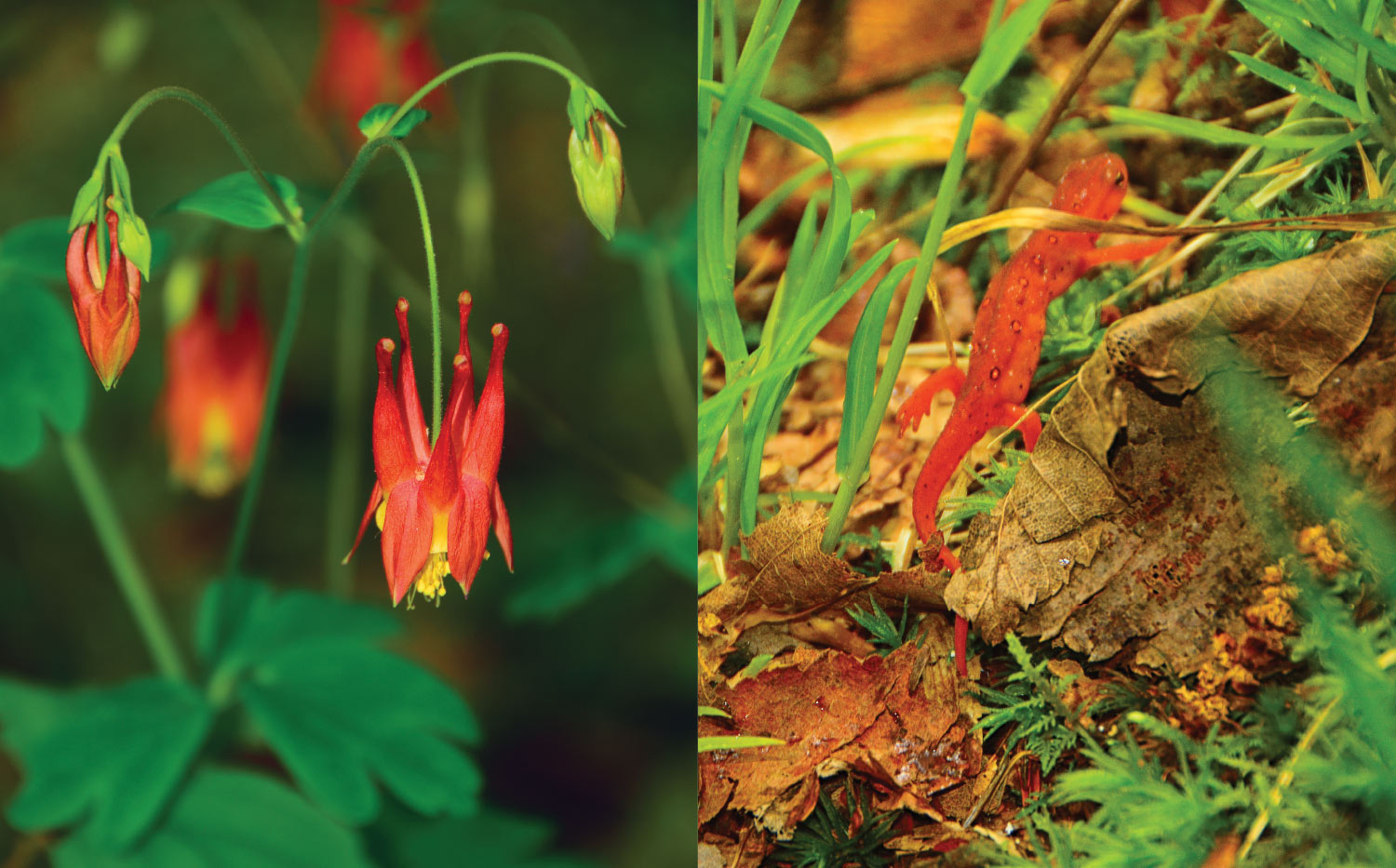Photo by Chris Gallaway/Horizonline Pictures
Photo by Chris Gallaway/Horizonline Pictures

Photo by Chris Gallaway/Horizonline Pictures
Above Drury and Kelly, a canopy of buckeye, sugar maple, basswood, yellow birch, and ash pattern the sky. A fluting song of a wood thrush filters through the leaf-struck sunlight. The understory brims with shade-loving plants, from the medicinal blue cohosh to mayapples. Within this haven of a Tennessee cove forest just off the A.T., life is both lush and fragile. Today Drury and Kelly are injecting systemic insecticides into a healthy tree in advance of attacks from devastating emerald ash borers. Their life-saving efforts are part of the largest landscape-level project aimed at preventing ash tree extinction in the Appalachian Mountains. What makes the A.T. ash project particularly ambitious is the focus on backcountry trees — far more difficult than injecting chemicals in ash near homes, on city streets and in parks, where most treatments take place.
While every ash is important, the trees that dwell among a thriving forest community are entwined with a suite of life — from pygmy salamanders hunting insects up moss-cloaked tree trunks to black bear mothers raising cubs. This ecosystem reaches beyond the A.T. footpath and its corridor. Saving ash trees is an essential component to the carefully orchestrated work to preserve the delicate, natural landscape that spans the eastern U.S.
Since 2016, the ATC and its partners have treated nearly 1,200 white ash trees surrounding the A.T., with more than 900 in the Southeast and 240 in New England. The work is costly, labor-intensive, and requires going back to dose their patients every three years and likely over the next few decades. So far, almost all those trees remain alive.
Photo by Shira Zaid
Now, hundreds of millions of ash trees across North America have succumbed to the beetles. Within two to three years after the larvae hatch and bore into the cambium below the bark, their feeding galleries cut off a tree’s transport system for water and nutrients. Every ash tree with a trunk bigger than your pinky finger is a potential target.

Photo by Matt Drury.
The ATC’s Matt Drury and partners from MountainTrue (Josh Kelly) and Hemlock Restoration Initiative (Thom Green) treat an ash tree at Spivey Gap.
Photo by Chris Gallaway/Horizonline Pictures

Along the A.T., primarily white ash and some green ash compose a vital three-to-five percent of shady forests. Hundreds of species of insects and spiders interact with ash and forty-four other species depend on them exclusively for survival. Wood frog tadpoles hatching in vernal pools grow larger, faster, and survive better when the leaves that fall into the water are from green ash. The trees host caterpillars so specialized to feed on them that some of the names contain the word “ash,” like the great ash sphinx moth. Songbirds like the scarlet tanager glean ash leaves for miniscule insects high up in the lofty tree canopy.
Photos by Chris Gallaway/Horizonline Pictures
Some treated trees with their diamond-shaped, corduroy gray bark even display the white A.T. blaze. I like to think hikers a century from now will place a hand on one of those blazes and celebrate the existence of a tree that came so close to extinction. Ash rely on wind pollination to send their clusters of oar-shaped samsara (wing) seeds into surrounding forests to plant hope for the future. Since the A.T. follows side slopes and ridges, the trees in these sections are well positioned for seeds to glide far into nearby forests.

Photo by Matt Drury
Kelly had returned to the same cove in 2021 to check on the trees within this 600-acre Moffett Laurel Botanical Area in the Cherokee National Forest. The borer had arrived, and the contrast could not have been starker. Already ninety percent of the unprotected ash had died, while at least ninety-five percent of those treated looked healthy. The trees are slated for their second injections this summer. “What we are doing is working,” Kelly says. “The ash trees that remain will provide the genetic pool for reestablishment.”
Among that lucky dozen safeguarded from the borer in the special cove is a thirty-nine-inch diameter wonder, the second largest ash of all treated so far under Drury and Kelly’s leadership. It took half of a $500 bottle to infuse this one tree. Impulsively, Drury gave the ash a name: the “Dave Richie tree” in honor of my dad who served as the A.T. project manager for the National Park Service in the 1970s and 80s, an era pivotal to securing a protected trail corridor from Georgia to Maine.
As the club’s natural resource coordinator, Pelletier helps to identify the best places to protect individual ash trees along the Trail in the Berkshires of western Massachusetts. He’s motivated to give back to the Trail that offers an accessible haven for people to reflect and find renewal in wild nature. “With all that’s going on in our world, our country, and our personal and work worlds, I think having this refuge is more important than ever,” he says.
The more intact the forested wilds, the richer the refuge for people and for the native flora and fauna of the Appalachian Mountains. The sites in Massachusetts selected for ash tree treatment are known for high biodiversity and presence of species of special concern. At one of the locations, the ATC has prioritized the removal of invasive barberry over 100 acres to stop the non-native shrub from outcompeting shade-loving plants. “We conducted restoration work at the site for six years until we missed one because of Covid-19, only to return and find the ash had begun to show signs of damage due to the ash borer,” Marian Orlousky says. They moved in quickly to treat the remaining healthy ash trees in 2021 and await the outcomes with cautious optimism. “Even if we eventually lose the ash from this site, slowing the loss over time will help maintain the canopy structure, reduce the influx of invasive species, and help protect the understory community,” she says.

Photo by Peter Brannon;
A healthy forest supports native flora and fauna like red columbine and red eft salamanders.
Photos by Raymond Salani III

Back on the A.T., Paul Merten, an entomologist with the U.S. Forest Service out of Asheville, North Carolina, joins Josh Kelly and Matt Drury. Merten started releasing parasitoid wasps in 2016 on sections of the A.T. closest to Asheville. The tiny stingless wasps from Asia are specialists that prey on the larvae or eggs of ash borers. “Trying a biocontrol is the Hail Mary pass in the fourth quarter. It’s do or die,” says Marten.
Some sites on the A.T. with at least twenty-five percent forest coverage of ash and contiguous forests met Merten’s protocol for releasing the wasps. The first site he found when hiking uphill on the A.T. was staggering in its richness of ash — forty percent of the forest. When Merten trapped an ash borer, he was ready to bring in the wasps that shipped live to his office from labs run by the APHIS (Animal and Plant Health Inspection Service) of the U.S. Department of Agriculture. His first box contained 1,200 of the wasps and three different species. He continued to set more of the borer predators free as the wasps arrived in weekly batches that summer of 2016. “The web of biology is convoluted,” he says. “When you insert a new organism into an ecosystem there is a lot of shock and things we cannot measure or perceive.”
Merten released wasps every two years at four sites from 2016 to 2019, making sure those areas do not overlap with those containing treated ash. Now, he monitors for their presence — setting up traps that look like yellow party bowls for ice cream. There are introduced parasitoid wasps showing up in the traps, and that’s good news. Biocontrol takes time and patience for results.

Photo by Shira Zaid
Drury is thrilled every time he comes back on a three-year rotation. He’s coming to know individual trees like old friends. “South of Max Patch, we treated 250 trees and all but two survived,” he says. “I’m driven to roll the dice on the unknown and be optimistic about the outcome.”
No one involved knows what’s in store ultimately, but what they do know is how it feels to gaze up into a living ash tree as winds lift clusters of winged seeds and send them spinning into a waiting forest. Thanks to every champion of the A.T. from inception to now, we can celebrate the possibility for large-scale conservation and renewal of forests and the human spirit.
A.T. hikers know what it is to persist in wind, mosquitos, mud, snow, endless uphills, and punishing heat, only to revel all the more in every beauty spot along the way. So it is with the ash tree protectors who marvel at each tree saved like another summit reached. The view could not be finer.